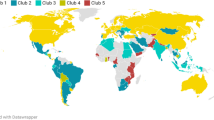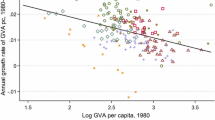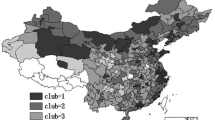Abstract
This study investigates the sources of heterogeneity across a worldwide set of countries. Unspecified ex ante and unanticipated cultural (Protestant versus Catholic), geographical (continents), and institutional (OECD versus non-OECD) clubs emerge endogenously and naturally as homogeneous classes on the basis of their economic structure. The dynamics both within and across the identified groups of countries are consistent with multiple equilibrium-growth models proposed by, for instance, Azariadis and Drazen (1990), therefore strengthening the viability of the convergence club hypothesis. In particular, higher stages of development are, on average, non linearly associated with higher stages of growth.
Similar content being viewed by others
References
Abramowitz, M. (1986). “Catching-up, Forging Ahead, and Falling Behind.” Journal of Economic History 46, 385-406.
Aoki, M. (1996). New Approaches to Macroeconomic Modeling: Evolutionary Stochastic Dynamics, Multiple Equilibria, and Externalities as Field Effects. Cambridge: Cambridge University Press.
Auerbach, A. J., K. A. Hasset, and S. D. Oliner. (1994). “Reassessing the Social Returns to Equipment Investment.” Quarterly Journal of Economics 109, 789-802 and reply.
Azariadis, C. (1996). “The Economics of Poverty Traps. Part One: Complete Markets.” Journal of Economic Growth, 449-486.
Azariadis, C., and A. Drazen. (1990). “Threshold Externalities in Economic Development.” Quarterly Journal of Economics 105, 501-526.
Barro, R. J. (1991). “Economic Growth in a Cross Section of Countries.” Quarterly Journal of Economics 106, 407-443.
Barro, R. J. (1997). Determinants of Economic Growth: A Cross-Country Empirical Study. Cambridge: MIT Press.
Barro, R. J., and X. Sala-i-Martin. (1992). “Convergence.” Journal of Political Economy 100, 223-251.
Benhabib, J. and M. M. Spiegel. (1994). “The Role of Human Capital in Economic Development: Evidence from Aggregate Cross-Country Data.” Journal of Monetary Economics 34, 143-173.
Breiman, L., and J. H. Friedman. (1985). “Estimating Optimal Transformations for Multiple Regression and Correlation.” Journal of the American Statistical Association 80, 580-598.
Buja, A. (1990). “Remarks on Functional Canonical Variates, Alternating Least Squares Methods and ACE.” Annals of Statistics 18, 1032-1069.
Cook, D., A. Buja, and J. Cabrera. (1993). “Projection Pursuit Indexes Based on Orthonormal Function Expansions.” Journal of Computational and Graphical Statistics 2, 225-250.
De la Fuente, A. (1995). “Catch up, Growth and Convergence in the OECD.” CEPR Discussion Paper 1274.
De Long, B. J. (1988). “Productivity Growth, Convergence, and Welfare: What the Long-Run Data Show.” American Economic Review 76, 1072-1085.
De Long, B. J., and L. H. Summers. (1991). “Equipment Investment and Economic Growth.” Quarterly Journal of Economics 106, 445-502.
De Long, B. J., and L. H. Summers. (1992). “Equipment Investment and Economic Growth: How Strong is the Nexus?” Brooking Papers on Economic Activity 2, 157-211.
De Long, B. J., and L. H. Summers. (1993). “Equipment Investment in Developing Countries.” Journal of Monetary Economics 32, 395-415.
Dowrick, S., and D. T. Nguyen. (1989). “OECD Comparative Economic Growth 1950-85: Catch up and Convergence.” American Economic Review 79, 1010-1030.
Durlauf, S. N. (1993). “Nonergodic Economic Growth.” Review of Economic Studies 60, 349-366.
Durlauf, S. N., and P. A. Johnson. (1995). “Multiple Regimes and Cross-Country Growth Behavior.” Journal of Applied Econometrics 10, 365-384.
Durlauf, S. N., and D. T. Quah. (1998). “The New Empirics of Economic Growth.” NBER Working Paper 6422, February. Forthcoming in John Taylor and Michael Woodford, eds., Handbook of Macroeconomics.
Easterly, W., and R. Levine. (1997a). “Africa's Growth Tragedy: Policies and Ethnic Divisions.” Quarterly Journal of Economics 112, 1203-1250.
Easterly, W., and R. Levine. (1998). “Troubles with the Neighbours: Africa's Problem, Africa's Opportunity.” Journal of African Economies, 7, 120-142.
Friedman, J. H. (1987). “Exploratory Projection Pursuit.” Journal of the American Statistical Association 82, 249-266.
Friedman, J. H., and J.W. Tukey. (1974). “A Projection Pursuit Algorithm for Exploratory Data Analysis.” IEEE Transactions on Computers C23, 881-890.
Galor, O. (1996). “Convergence? Inferences from Theoretical Models.” Economic Journal 106, 1056-1069.
Harberger, A. C. (1987). “Comment.” NBER Macroeconomics Annual, 255-258.
Härdle, W. (1990). Applied Nonparametric Regression. Econometrics Society Monographs 19, Cambridge University Press.
Härdle, W., S. Klinke, and B. A. Turlach. (1995). XploRe: An Interactive Statistical Computing Environment. Springer-Verlag New-York Inc.
Hassink, R. (1994). “South Korea: Economic Miracle by Policy Miracle?” MERIT Research Memorandum 2/94-023-Maastricht.
Huber, P. J. (1985). “Projection Pursuit.” Annals of Statistics 13, 435-475.
Inglehart, R. (1997). Modernization and Postmodernization: Cultural, Economic, and Political Change in Fortythree Societies. Princeton, NJ: Princeton University Press.
Krugman, P. (1991). “History Versus Expectations.” Quarterly Journal of Economics 106, 651-667.
Murphy, K. M., A. Shleifer, and R. W. Vishny. (1989). “Industrialization and the Big Push.” Journal of Political Economy 97, 1003-1026.
Mankiw, N. G. (1995). “The Growth of Nations.” Brooking Papers on Economic Activity 1, 275-326.
Mankiw, N. G., D. Romer, and D. Weil. (1992). “A Contribution to the Empirics of Economic Growth.” Quarterly Journal of Economics 107, 407-437.
Matsuyama, K. (1991). “Increasing Returns, Industrialization, and Indeterminacy of Equilibrium.” Quarterly Journal of Economics 106, 617-650.
Murphy, K. M., A. Shleifer, and R. W. Vishny. (1989). “Industrialization and the Big Push.” Journal of Political Economy 97, 1003-1026.
Quah, D. T. (1996). “Twin Peaks: Growth and Convergence in Models of Distribution Dynamics.” Economic Journal 106, 1045-1055.
Quah, D. T. (1997). “Empirics of Growth and Distribution: Stratification, Polarization, and Convergence Clubs.” Journal of Economic Growth 2, 27-59.
Romer, P. (1986). “Increasing Returns and Long Run Growth.” Journal of Political Economy 94, 1002-1037.
Romer, P. (1990). “Endogenous Technological Change.” Journal of Political Economy 98, S71-S102.
Sala-i-Martin, X. (1996). “The Classical Approach to Convergence Analysis.” Economic Journal 106, 1019-1036.
Sala-i-Martin, X. (1997). “I Just Ran Two Millions Regressions.” American Economic Review (Papers and Proceedings), 178-183.
Temple, J., and P. Johnson. (1998). “Social Capability and Economic Development.” Quarterly Journal of Economics 113, 965-990.
Author information
Authors and Affiliations
Rights and permissions
About this article
Cite this article
Desdoigts, A. Patterns of Economic Development and the Formation of Clubs. Journal of Economic Growth 4, 305–330 (1999). https://doi.org/10.1023/A:1009858603947
Issue Date:
DOI: https://doi.org/10.1023/A:1009858603947




